Necessary Optimality Conditions for a Class of Impulsive and Switching Systems
Abstract
An optimal control problem for a class of hybrid impulsive and switching systems is considered. By defining switching times as part of extended state, we get the necessary optimality conditions for this problem. It is shown that the adjoint variables satisfy certain jump conditions and the Hamiltonian are continuous at switching instants. In addition, necessary optimality conditions of Fréchet subdifferential form are presented in this paper.
1. Introduction
In a broad sense, hybrid systems are control systems involving both continuous and discrete variables. Much attention has been paid on the control of hybrid systems in recent years, see [1–27] and references therein. Impulsive and switching systems are a particular class of hybrid systems characterized by switches of states and abrupt changes at the switching instants. Many real-world processes such as evolutionary processes, flying object motions, signal processing systems, and so forth, can be modeled as impulsive and switching systems. Therefore, it is important to study the properties of this kind of systems. In [1], by using switched Lyapunov functions, Guan et al. gave some general criteria for exponential stability and asymptotic stability of some impulsive and switching models. The robust stability conditions for several types of impulsive switching systems were presented in [2–5]. Sufficient conditions for exponential stability and input-to-state stability of nonlinear impulsive switched systems were established in [6, 7]. All of these papers concentrated on the stability of impulsive and switching systems.
Over the last few decades, there have been a large number of researches on optimal control of hybrid systems. Different approaches have been proposed in this fields, such as the viscosity solution technique [8], dynamic programming methods [9–11], the embedding approach [12], direct differentiation of the cost function [13–15], necessary optimality conditions [16–24] and the method of smoothed approximation [25].
In [26], Gao et al. investigated optimal control problem for a class of impulsive and switching systems, where the impulses and switches occurred at fixed instants. Taking advantage of Ekeland’s variational principle, they obtained the necessary optimality conditions for the continuous parts. In this paper, we consider similar problems with unfixed impulsive and switching instants. By introducing a new time variable, we get necessary optimality conditions for the continuous parts and the switching instants. Compared with the continuous parts, the necessary conditions at the switching times is more challenging and difficult to obtain. Furthermore, by applying Fréchet subdifferential, we give necessary optimality conditions with nonsmooth cost functional. Usually, the advantage of hybrid system lies in its nonsmooth trajectory. Therefore, the use of nonsmooth objective functional can reflect this advantage better.
The rest of the paper is organized as follows. In Section 2, the problem is formulated. In Section 3, necessary optimality conditions with smooth and nonsmooth cost functional are presented. Section 4 concludes the work.
2. Problem Formulation
Optimal control problem for (2.4) was considered in [26], where the switching instants were fixed. In this paper, we consider such a problem with unfixed switching times, which is more flexible in practical applications.
To this end, let (x0, u0) be a solution of problem (P) with a piecewise continuous control function u0.
3. Necessary Conditions of Optimality with Smooth Cost Functional
Now we give a necessary condition for problem (P).
Theorem 3.1. There exist a piecewise continuously differential variable λ(t):[t0, tN] → ℝn, multipliers μ ∈ ℝ and λ0 ∈ ℝ, such that (x0, u0) satisfies
Proof. For i = 1, …, N, define
The Hamiltonian of problem (Q) is denoted by .
Applying classical necessary optimality conditions to problem (R), there exist λi(s) ∈ ℝn, i = 1, …, N, , i = 1, …, N − 1, ξi ∈ ℝ and ωi ∈ ℝn, i = 1, …, N − 1, such that for
For autonomous system, the Hamiltonian is constant along the optimal trajectory, so the right hand of (3.11) is constant on [0,1]. Combining (3.11) with the boundary conditions (3.15) and (3.16), We get the continuity condition (3.4).
Recombine the adjoint variable
Remark 3.2. Besides the necessary optimality conditions for the continuous parts and the terminal costate, which were derived in [26], Theorem 3.1 also give the necessary optimality conditions for the switching instants. Therefore, Theorem 3.1 is an important improvement and generalization of the main results in [26].
Example 3.3. Minimize the cost functional
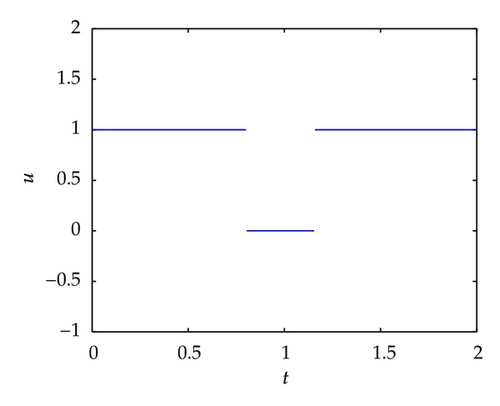
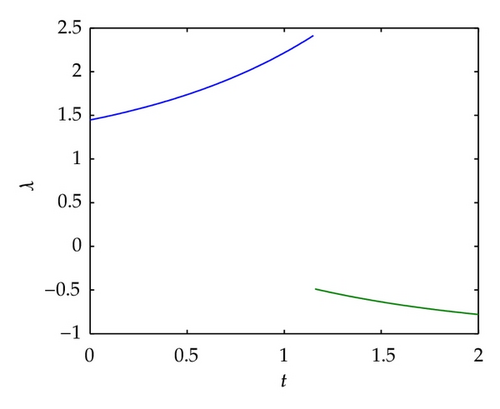
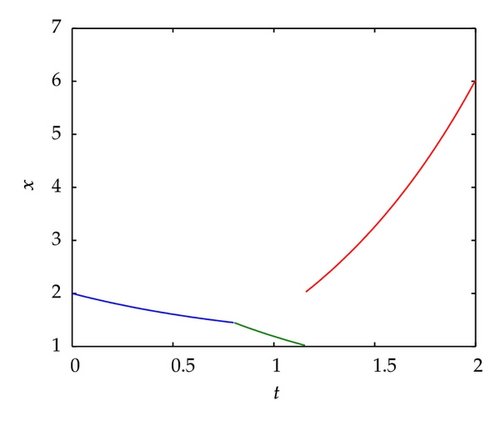
4. Necessary Optimality Conditions with Nonsmooth Cost Functional
To establish superdifferential form of necessary optimality conditions, we shall introduce some basic knowledge of nonsmooth analysis. For more knowledge, the reader can refer to [18, 28].
Similarly, if φ is supper semicontinuous, we can define the Fréchet supperdifferential of φ at by . For example, let φ(x) = |x|, then and .
Lemma 4.1 (see [18], [28].)Let φ : X → ℝ, . Then for any , there exists a function s : X → ℝ with and s(x) ≤ φ(x) whenever x ∈ X, such that s(·) is Fréchet differentiable at with .
Theorem 4.2. Let (x0, u0) be a weak local minimum of problem (P), φi is Fréchet subdifferentiable at x0(ti), then for every , i = 1,2, …, N, the results of Theorem 3.1 hold except that (3.1) and (3.4) are replaced by the following:
Proof. For any , taking advantage of Lemma 4.1, there exist functions si, such that they are Fréchet differentiable at and the following conditions are satisfied: , , and si(x(ti)) = φi(x(ti)) in some neighborhood of , i = 1, …, N. Therefore (τ0, x0, u0) is a weak local minimum of problem (P3): Minimize the functional
Example 4.3. Minimize the cost functional
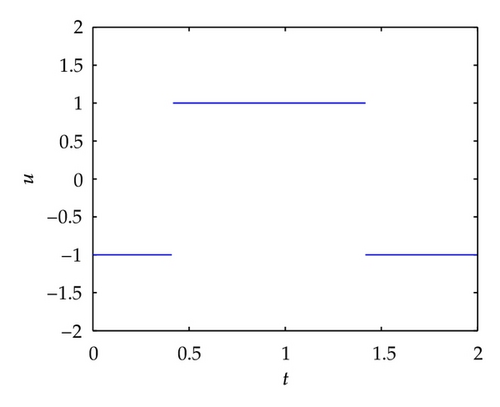
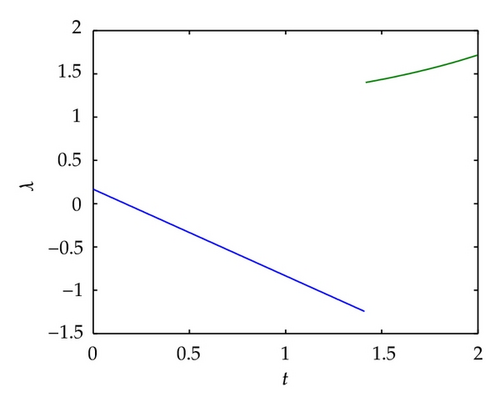
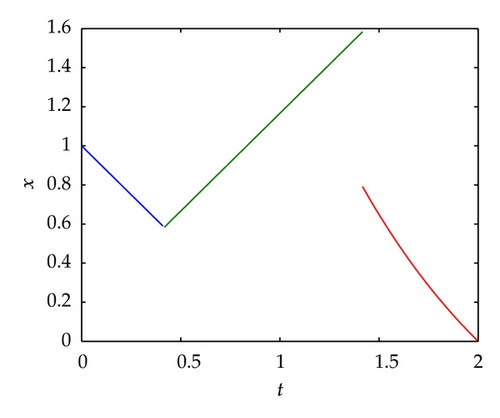
Remark 4.4. As shown in Example 4.3, the necessary optimality condition of Fréchet subdifferential form allows us to get the optimal switching point for the problem with nonsmooth cost functional, but the usual necessary optimality conditions fails to do this.
5. Conclusions
In this paper, we have investigated optimal control problems for a class of impulsive and switching systems, where the switching transitions are unfixed. By defining the switching instants as part of extended state and taking advantage of the knowledge of nonsmooth analysis, the necessary optimality conditions with both smooth cost functional and nonsmooth cost functional are derived, which are the substantial extension and generalization of some known results in the literature.
Acknowledgments
This work is supported by National Science Foundation of China (no. 11171221), Science and Technology Commission of Shanghai Municipality (no. 10550500800), and Shanghai Education Foundation for Innovational Scientific Research Foundation (no. 11YZ193).




